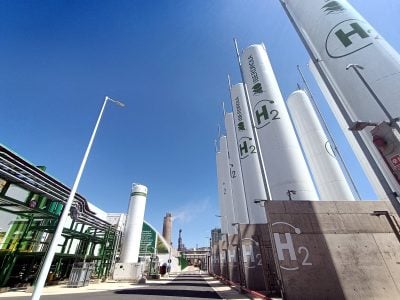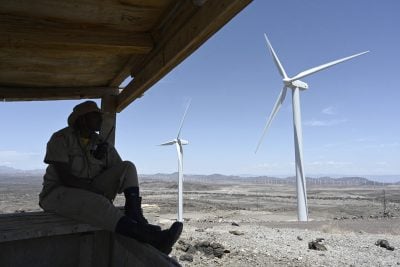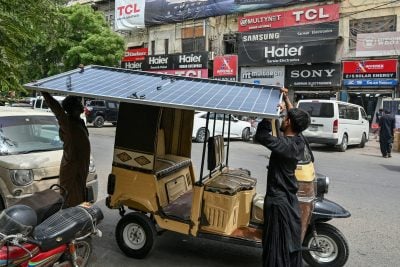Hydrogen is a versatile element that is in growing demand. It provides a feedstock for industries such as iron and steel, petrochemicals and ammonia, it can be used in power generation, and it is used in low-carbon fuel cells for the transport sector and for energy storage.
But the hydrogen industry needs to clean up its act, if it is to be part of the solution to meeting climate change targets. Currently hydrogen production relies heavily on fossil fuels as feedstock – the most common production method involves creating hydrogen from natural gas, which produces carbon dioxide as a byproduct.
The good news is that hydrogen can be produced cleanly using electrolysis to split water to produce so-called green hydrogen and oxygen, and it’s a technology which is in increasing demand as countries seek to meet their climate change obligations under the Paris climate change treaty.
Global capacity of electrolysers, which are needed to produce hydrogen from electricity, doubled over the last five years to reach just over 300 MW by mid-2021. Around 350 projects currently under development could bring global capacity up to 54 GW by 2030, according to the International Energy Agency.
But, in addition to a local supply of water, producing hydrogen via electrolysis requires copious amounts of electricity, making it expensive, and for the hydrogen to be truly green the power needs to come from low-carbon sources such as renewables.
Benefits of a green hydrogen industry for Africa
That’s where Africa comes into the picture. Blessed with vast untapped solar and wind resources and plenty of space to develop them, African countries are hoping to tap these resources to create their own green hydrogen sectors.
The attractions are clear: the development of green hydrogen will bring in investment and create jobs. It could drive the domestic use of hydrogen for power, industrial uses and transport in the long-term – and before that, exporting green hydrogen to meet surging demand in Europe and other overseas markets would provide valuable revenues.
A green hydrogen industry would also benefit the development of renewables, not just because it creates demand through its heavy power requirements, but also because it could use the power on a flexible schedule, providing steadier revenue streams from intermittent solar and wind energy.
A hydrogen plant would effectively add to offtake options for renewables providers, taking solar and wind output when that exceeds demand from other users – or when the grid is down, a common occurrence in many parts of the continent. Then the plant could scale back production when grid demand picks up to allow renewable power to be redirected to other users.
A number of African countries – backed by funding and other support from enthusiastic international development agencies and financial institutions – have already joined the race to become established as hydrogen hubs.
Various projects have been announced, though most remain in the early stages of development. Egypt has at least five green hydrogen projects in the pipeline. Mauritania, Morocco, Namibia, Niger and South Africa have also drawn up plans for hydrogen production facilities.
Mauritania’s grand plan
One of the most ambitious is Project Nour in Mauritania, a planned development to provide 10 GW of renewable energy for a green hydrogen development, outlined in an MoU signed in September 2021 by Mauritania’s Ministry of Petroleum, Mines, and Energy of Mauritania with UK-based Chariot Energy Group.
The focus initially will be on identifying and developing solar and wind energy sites across an onshore and offshore area covering some 14,400 sq km. No timetable has been outlined for the project, which would export hydrogen to the European market.
“Developing Mauritania’s green hydrogen industry promises to bring a combination of environmental, economic and social benefits to our country. We have the potential, and desire, to be a world leader in the field of hydrogen production from renewable energy sources,” Abdessalam Ould Mohamed Saleh, Mauritania’s Minister of Petroleum, Energy and Mines said on announcing the project.
Landlocked Niger is also seeking to take advantage of its abundant Saharan solar resources to power green hydrogen projects. Germany’s Emerging Energy Corporation signed an agreement with the government in February 2022 to scope out potential sites and development types.
Sasol lines up South African projects
South Africa is one of the few sub-Saharan countries with the potential to develop a sizeable home market for green hydrogen, as well as producing for export. It is also keen to promote the hydrogen fuel cell sector, because it holds more than 90% of the world’s deposits of platinum, a key component in fuel cells.
South African energy and chemicals firm Sasol has said it plans to start producing 6 tonnes a day of green hydrogen at its Sasolburg plant by 2023, using 60 MW of renewable electricity.
The company also signed an agreement with the Northern Cape Development Agency in October 2021 to conduct a two-year feasibility study to assess the potential of Boegoebaai, near Port Nolloth, as a potential location for green hydrogen and green ammonia facility.
Sasol says the project could produce up to 400,000 tones/year of green hydrogen, based on 9 GW of renewable electricity at an estimated cost of $10bn.
Neighbouring Namibia selected Hyphen Energy as preferred bidder to develop the country’s first large-scale green hydrogen project in November 2021. The site near the Tsau Khaeb National Park would tap promising local solar and wind resources and is close to Luderitz, providing a port for exports.
The $4.4bn planned first phase would produce up to 300,000 tonnes/year of green hydrogen, powered by 2 GW capacity of renewable electricity by 2026, with plans to scale up further in the late 2020s. Output would either be sold as hydrogen or processed into green ammonia.
North Africa looks to European markets
However, it is North African countries that are perhaps best placed to deliver large-scale green hydrogen projects, not only having substantial existing industrial infrastructure, but also having an ideal location for exports across the Mediterranean to Europe.
At least five green hydrogen projects have been mooted for Egypt, though only one currently has an indicated completion date.
In October 2021, Norwegian renewables developer Scatec signed an agreement with Fertiglobe plc, and the Sovereign Fund of Egypt, to jointly develop a 100 MW green hydrogen facility as feedstock for green ammonia production. Fertiglobe is an ammonia producer jointly owned by OCI NV and Abu Dhabi National Oil Company.
Scatec will build, operate and majority own the facility and a long-term off-take agreement will be entered into with Fertiglobe’s subsidiary Egypt Basic Industries Corp (EBIC). It could be onstream by 2024. The facility will be located near the EBIC facility in Ain Sokhna in the Suez Canal Zone, where Scatec is also involved in a consortium building a plant to produce up to 3m t/y of green ammonia.
Morocco has said it wants to put the development of a global hub for green hydrogen at the heart of its industrial strategy. The first project to emerge is a $10bn green hydrogen and ammonia development in the Guelmim-Oued Nour region of southern Morocco, led by French power producer Total Eren. Power will come from 10 GW of wind and solar power generation, with first production forecast for 2027.
Want to continue reading? Subscribe today.
You've read all your free articles for this month! Subscribe now to enjoy full access to our content.
Digital Monthly
£8.00 / month
Receive full unlimited access to our articles, opinions, podcasts and more.
Digital Yearly
£70.00 / year
Our best value offer - save £26 and gain access to all of our digital content for an entire year!
 Sign in with Google
Sign in with Google 



